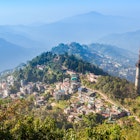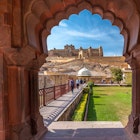
Expert tips for your first trek to the Indian Himalaya
May 22, 2013 • 5 min read

Yearning to explore the forbidding peaks of the Indian Himalaya, but not sure where to start? These expert tips from a seasoned trekker will help you dodge the newbie mistakes and ensure your journey exceeds expectations.

Planning your trip
Thorough planning (or lack of it) can make or break a trip, so take the time to master your budget, time your trek and assemble the perfect itinerary.
- placement: fullWidth
- path: articles/in-content-top
- possible size: [970, 250], [970, 90], [728, 90], [300, 250], [320, 50], [1, 1],
- targeting:
{ "url": "expert-tips-for-your-first-trek-to-the-indian-himalaya-2", "destination": "India", "continent": "Asia", "country": "India" }
Design an itinerary
Do your interests lie in centuries-old culture or do remote mountain passes appeal? For ancient monasteries, Ladakh or Little Tibet are the places to go. If you want to trek through luxuriant forests then consider exploring Sikkim. For spectacular mountain views, the little-trekked trails of the Garhwal are on par with the best in the Himalaya.
Above all, don’t be too ambitious with your itinerary. Allow plenty of contingency days for acclimatisation, inclement weather, porters that disappear without notice for half a day, village celebrations, or taking an extra day to savour a stunning campsite. Understanding the Himalaya would take lifetimes to achieve, so don't expect to master the mountains on a single trip.
Set your budget
If you're trekking independently, work out the cost of hiring a guide, porters, food, accommodation and transportation - and then double it. That should take care of all other unforeseen costs that always seem to creep into a tight budget. If your arrangements are made by a trekking agency, plan to keep money at hand for tips (likely to come to 10% of your total budget).
Time your trek
March until June are often considered peak trekking season, but make sure you stay weather-aware throughout your trip. The Himalaya are subject to a weather pattern so complex that even experienced travellers can find themselves caught out. The regions of Himachal, Uttaranchal Darjeeling and Sikkim are subject to heavy monsoon rains so avoid July and August if possible. The Indian Himalaya also experience a long and cold winter from mid November until March – during this period, it’s best to head to Nepal.
Safety first
- placement: fullWidth
- path: articles/in-content-middle
- possible size: [970, 250], [970, 90], [728, 90], [300, 250], [320, 50], [1, 1],
- targeting:
{ "url": "expert-tips-for-your-first-trek-to-the-indian-himalaya-2", "destination": "India", "continent": "Asia", "country": "India" }
Your travel planning needs to go beyond government travel advisories. Trekking is a specialist activity so read up on acclimatisation (it could save your life) and don't assume you can rely heavily on your GPS when you're out there. Even the most detailed contour maps tend to be unreliable in some remote areas, so your best investment by far would be hiring an experienced local guide.
Check your gear
There's no one to impress in a remote mountain pass, so forget fashion and make sure your gear is sturdy enough to withstand the changeable mountain weather. There is no reason to invest in all the latest outdoor gear, provided your trekking gear is in good shape. Unlike Nepal, good gear still comes at a premium in India. If your arrangements are being made by an agent, double-check what is included. When in doubt you’re best to at least bring your own sleeping bag and sleeping mat and even your favourite (lightweight) tent.
Tips for the trek
So you made it to the mountains; here's how to protect your gear, pace yourself and befriend the locals.
Be positive and pace yourself
Being in the right frame of mind is equally as important as your physical preparation. High altitudes aren't the place to unleash fraught emotions, so try to keep calm during frustrating moments, and leave enough leeway in your itinerary that you won't feel flustered if your plans go awry. Keep your trekking to the same pace as the locals. Your trekking mantra should be ‘short steps, deep breaths’, particularly when ascending steep passes or completing long uphill stretches. And don't cross rivers or swift flowing streams barefoot: your boots will always dry out, but sprained ankles equal end of trek.
Protect your gear
Use a sturdy kitbag for your trekking gear: these can easily be replaced after constant contact with thorn bushes, jagged rocks and being offloaded into dusty campsites, but don’t risk damaging your expensive rucksack (by having it strapped directly to a mule). And while it's tempting to walk with your camera at the ready, your chances of spotting a snow leopard on a distant ridge are on par with winning the lottery. Dusty trails and expensive cameras don’t mix, and a slip on the trail could result in untold damage to your photography gear.
Keep your essentials at hand
- placement: native
- path: articles/in-content-native
- possible size: [f, l],
- targeting:
{ "url": "expert-tips-for-your-first-trek-to-the-indian-himalaya-2", "destination": "India", "continent": "Asia", "country": "India" }
Always carry your water- and wind-proof jacket with you, together with a dry pair of socks and a spare sunhat (or two - they're all too easy to leave behind after a rest stop). A supply of stuff bags is a good investment, to ease the constant cycle of packing and repacking. Buy an umbrella locally, not just to keep off the sun and rain, but also to shield your modesty during mountainside bathroom breaks.
Be courteous and flash a smile
Get into the habit of saying a Salam, Namaste or Julay while on the trail. Remember that the local people are always interested (or amused) that you have travelled half way around the world to meet them. Carry a few photographs from home to show them your family or friends, and that will help to break down the cultural barriers. But don't assume you can get snap-happy with local people: photography in some remote regions can cause offence. Wait for permission (a smile at least) before bringing out your camera.
Respect the environment
Don't start wood fires or pollute water sources - you might be thousands of miles from home, but the smallest careless actions can be disastrous for local ecosystems and people. Plan to leave with the rest of the trek crew to ensure that your campsite is cleaned up and garbage carried out (it's eco-conscious, and also avoids the possibility of any of your belongings being accidentally discarded).
Medical matters
Bring your essential medication, but be selective about taking other medicines along with you. Many brands can be purchased without prescription in India. But whatever your medical background, do not treat local people. Except in extreme emergencies, you will do more harm than good. Supplying antibiotics may seem helpful, but it may discourage the patient from seeking long-term advice from a local medical practitioner.

Ready to lace up your hiking boots? Make some room in your rucksack for a copy of Lonely Planet's Trekking in the Indian Himalaya travel guide.
Not cut out for camping? Try one of Lonely Planet's expert-reviewed Nepal hotels and hostels instead.
- placement: fullWidth
- path: articles/bottom
- possible size: [970, 250], [970, 90], [728, 90], [300, 250], [320, 50], [1, 1],
- targeting:
{ "url": "expert-tips-for-your-first-trek-to-the-indian-himalaya-2", "destination": "India", "continent": "Asia", "country": "India" }
Explore related stories


 HikingThe 12 best hikes in India, from the high Himalayas to the steamy Western Ghats
HikingThe 12 best hikes in India, from the high Himalayas to the steamy Western GhatsDec 15, 2023 • 16 min read

 HikingHighlights of the Seven Sisters: why Northeast India is the place to travel right now
HikingHighlights of the Seven Sisters: why Northeast India is the place to travel right nowOct 10, 2019 • 9 min read





